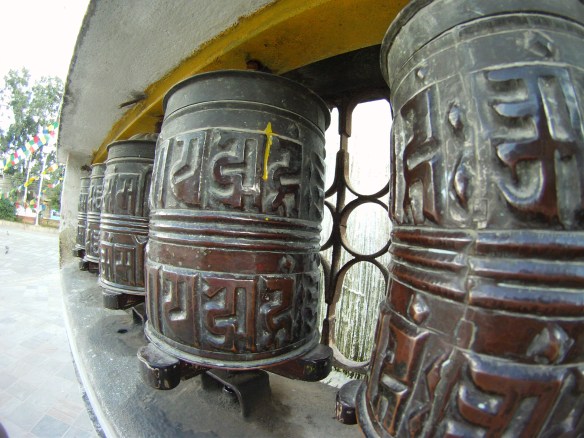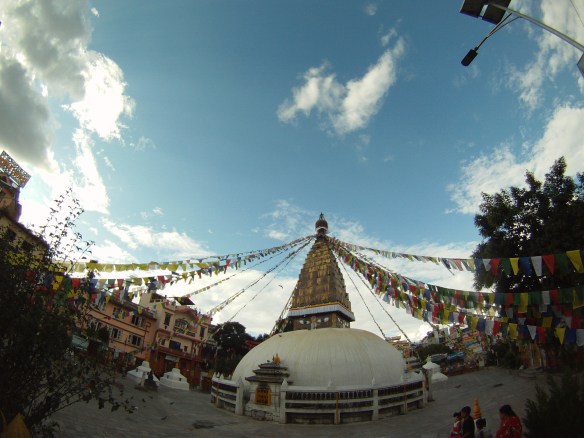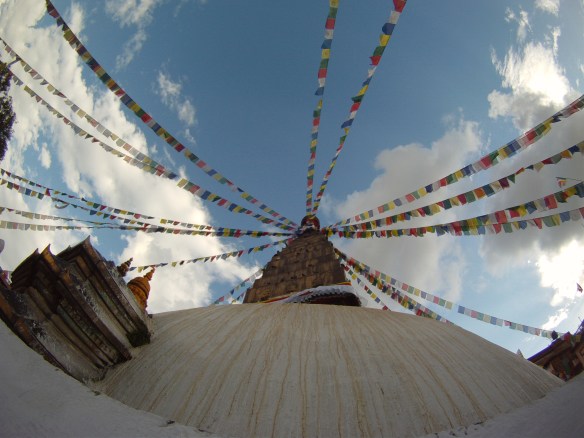
Boudhanath Stupa, Kathmandu. The Stupa was badly damage in last years earthquake and has been under construction since. It is located on the ancient trade route from Tibet and was built around 600 C.E.
Kathmandu is that invokes thoughts of exotic Buddhist and Hindu monasteries, surrounded by snow covered mountains. To me its a city of memories. During my family’s Buddhist pilgrimage in 1992 we spent a least a month in the city; visiting monasteries and traveling about the busy narrow roads. As a boy I clearly remember circum-ambulating the Buddhist Stupa in Boudha, eating Tibetan dumplings (Mo Mo), and playing with my brother in the courtyard of the small guest house we frequented. At 8 years old, Nepal was so different from the other foreign countries I had visited and was shocked to see beggars with leprosy sleeping on the streets, and little children without parents looking through trash for food. At the time, in America, my school friends were talking about BMX bikes and baseball, and here I was on the other side of the world looking into the eyes of children my age who would spend the rest of their lives living on the streets.

Downtown riverfront homes
The city seems to have changed very little in the last 25 years. Roads are still in extremely poor condition and power outages occur daily throughout. Looking down at Kathmandu from the mountains above the city looks as if it were on fire. The whole valley which makes up the city and its districts was covered in a cloud of thick smoke from vehicle exhaust and burning trash. Upon arrival I descended into what seemed like a wasteland and slowly navigated my way through a muddy dirt track filled with pot holes and trucks carrying loads of gravel. Soon I progressed into a more downtown area and found myself in a large market full of goats. Almost as if this were some sort of petting zoo, people were moving all about inspecting the bellies and backs of these four legged creatures and leading them around on rope leashes. Buses and cars drove passed with goats tied to their roof, I even saw a lady holding a goat on her lap as she squeezed on to the back of a moped.
My first stop in the city was the Myanmar Embassy and after the 30 minutes of pedaling through the city to get there I was greeted by a friendly Burmese Ambassador who asked me if I wanted to use their shower. After a few inquires I was told that the Indian/Myanmar border permit which I was hoping to get would not be issued to me and that if I wanted to get a Myanmar visa I would have to fly into the country (No Myanmar on this trip). Worse, I also found out that I had arrived the day before the Hindu holiday of “Dashain”, (a 7 day festival celebrating the Hindu Goddess Kali’s triumph over evil). This was one of Nepal’s largest holidays meaning all businesses would be closed, hotels would be sold out and prices of everything would be doubled.

Early morning pilgrims Boudha
The population of Kathmandu is close to 1 million yet when pedaling the streets it would be easy to fool your self into thinking was 10 million. The traffic is terrible! The entire country of Nepal still does not have a reliable source of electricity so there are no traffic signals! Intersections are therefore large round-abouts with traffic going in all directions. I have found that this can be OK during non-rush hour periods but during all roads are backed up for miles with local traffic police trying to guide traffic. This turns the small dirt sidewalks into runways for motorcycles trying to cut the barrage of vehicles. Pedestrians have little choice but to jump out of the way as the bikes honk their way through groups of people. Other than the intersections the traffic problem can be attributed to the lack of bus stops! Throughout the city buses stop in all lanes picking up and dropping of passengers making the traffic even worse.
All this chaos is made possible by the use of the horn. “Honk Honk”- I am here, “Honk Honk” – I am turning, “Honk Honk” – get out of the way. I have quickly learned the distinction in sound between the horns of trucks, cars and motorbikes, and have found that it is not uncommon for a truck to honk once as a warning, then push you out of the road. Side and rear view mirrors are rarely used, and it seems that it is the drivers responsibility to “Honk” when caution is needed. In Kathmandu the automotive horn may add more to the safety of the people than seat belts!

A smaller Buddhist Stupa “Little Boudhanath” a few km south of Boudha.
Pedaling into Boudha, the Buddhist hub of the city, I found the historic Stupa surrounding by wooden scaffolds. Last years earthquake had extensively damaged the Stupa and it was no longer possible to walk up to the temple mount. The square surrounding the Stupa however was exactly as I remembered it. Full of Tibetans selling jewelry and butter lamps. The same restaurants that were frequented in ’92 were still in business and the little guest house was still there, but completely booked for the holiday.

Nepali women light butter lamps on the early morning streets of Boudha.
Boudha seems to be the only place where businesses remained open as outside everything closed, temples filled and sidewalks became covered in goats blood as the Hindu majority prepared for the holiday. The once busy streets became quiet and the honking slowly faded. Unexpectedly my rear skewer which holds my wheel on broke! Trying to find an open bike shop was like looking for something open on Christmas! Pushing my bike I soon passed a motorcycle garage where I became friends with the owner. “You will not find a bike shop till next Friday” he said. “But I can give you a ride back to Boudha on my motorbike”. Putting Esperanza over my right shoulder I climbed on to the back of his bike and we took off through the city. We passed miles and miles of closed businesses and it looked as if the city were abandoned. Soon we reached a different part of town where everything was open, shopping malls, clothing shops, Trekking gear warehouses, etc. “This is the foreigner section of the city” He said “it’s called Thamel and many Muslims live there”. That explained the open businesses, and we soon passed a bike shop that sold me what I needed. We continued on weaving through traffic with my tires spinning in the wind, and I wondered what life would be like living in the busy city.

I have spent the last three days in the city and have managed to alleviate the problem with my laptop. It still rains everyday blocking the views of the mountains but tomorrow I am headed on a circuit to the base of Everest. From there I will pedal back into India and into Bhutan. I will write again soon!
